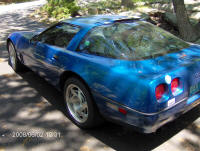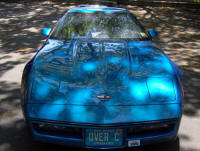RIKLBLOG
|
| Tomorrow |
| 21 Jan. 2009 |
| Yesterday |
| Index |
| Eventide |
| SETI League |
| PriUPS Project |
| Bonus! |
| Contact |


Premeditated Acts of Commutation
I commute. Shamelessly and with malice aforethought. Most days I get in the Prius and drive to work. Later that same day I get in the Prius and drive home. Scandal! The Prius that I normally drive has accumulated about 80,000 miles, close to the mileage if not the temporal limit of the extended hybrid warranty, so my thoughts with greater frequency have been turning to the notion of buying a new "plug-in" hybrid. My commute is asymmetrical. My place of striving is near sea level; I live at the top of a hill. This combination guarantees spectacular gas mileage going to work and poor mileage coming home. It also makes certain aspects of using a plug-in problematic. But most importantly, it has lead to a thought-invention that will revolutionize the automobile world.
A Plug-in-Hybrid Conundrum
The idea behind the plug-in is that, at least for a limited number of miles, the car will run solely on electricity. For example, the GM Volt, when it exists, is touted to run 40 miles on battery before the generator needs to kick in. This theoretically means that, at least for most people's commutes, no gas would be needed at all in one direction, and possibly in both directions if they could recharge at work (as I can). But there's an issue that I haven't seen discussed, at least not in the news or on the web. Electric motors and batteries are great at providing peak horsepower. Small gasoline engines are great at providing steady energy, i.e., kW-hours per gallon of gas. But what if you have a commute like mine? If you live on top of a hill, approximately one battery-range from work, you might be arriving home just as your battery is becoming fully discharged. Of course the generator will kick in to charge the battery when needed, which will provide power to the electric motors, and you will make it home. But the designers of the car must provide a large enough internal combustion engine (ICE) generator to make sure that you won't have to creep uphill for the final miles. And that's not good! The vast majority of the time one should be driving on electricity only. You will only need the relatively large ICE for a few minutes per day. Having a large ICE makes the car more expensive to build and less efficient to operate due to the engine's weight.
I use my commute as an example, but this is a general problem, both for customers and also for manufacturers. If the Volt were built without any ICE, it would have a range of just 40 miles and nobody would buy it. If it were built with an ICE but no battery, it wouldn't be a Volt. There should be an optimum size for an ICE that will give the best compromise between weight, efficiency, and customer acceptance. My revolutionary invention is intended to change this equation, and allow the car manufacturer to use a smaller ICE and gain the attendant benefits, without penalty! Here's how it works:
My Revolutionary Invention
On the dashboard of all cars there are a number of controls—knobs and such—that operate the radio, heating, windshield wipers and so forth. I propose to add an additional control. It would turn to one of three positions, or perhaps toggle among them. Attached to the back of this control would be wires connected to the car's computer, which, of course, is what actually does the work. The control would adjust the electrical conductivity among the wires so that the computer could tell which way it was turned or toggled, and do one of three things depending on how the driver adjusted it:
-
Keep the generator OFF for an "EV" mode when silence is desired
-
Put the generator on AUTOMATIC, i.e., have it controlled by the computer as it would normally be
-
Keep the generator ON to charge the battery even when not strictly necessary
The beauty of this invention is that it would allow the driver to substitute his knowledge of the forthcoming trip for the car's necessary ignorance. Let's say I'm going home, and I know that the distance I have to travel will just about exhaust the range of the battery. If I leave the switch on AUTOMATIC, the generator will kick in just as I'm about to climb my hill, meaning I will need a biggish generator. But, knowing that I have this hill to climb, I can turn on the generator when I'm, say, five miles from home, which will deposit extra energy in the battery. This will assure that there will be sufficient electric power to get me home in fine style. In this case, a much smaller generator will suffice since it will have longer to charge the battery than it would under computer control.
Of course, notwithstanding the setting of the dashboard control, the computer will have the job of preventing the battery from becoming over- or dis-charged, as it does on the Prius and undoubtedly will on the Volt. By adding this simple control, it should be possible to get away with a smaller ICE in a plug-in hybrid. One problem is that under some trip conditions, e.g., crossing the Rockies, even leaving the proposed smaller ICE on 100% of the time might be insufficient for the energy requirements of the trip. In which case the car manufacturer could offer the usual "available" bigger engine for people who might need it. But for most commuting, even a tiny ICE should be sufficient. By adding the driver to the hybrid control loop, enormous savings can be realized. The cost of adding my invention to the vehicle is close to negligible, despite the royalties I shall surely be offered.
Q: Richard: About Your Invention...
A: What about it?
Q: I'm not sure you're the first person to come up with
something like this.
A: No? What do you mean?
Q: This invention has existed for several years. It's
called a "switch."
A: Shot down again! I thought I might have seen something like
it before. Do you suppose I can patent "wire"?
Too Little Information
|
One Moment Please, The Hard Drive Is Powering Up |
If you are having trouble reading the rest of this item, cleverly hidden behind the short albeit largely-fonted message above, it's just because I'm using this format to mock the cable teevee box, which apparently can't do anything useful without a full-screen alert that blocks the picture. Too bad, really, as the treasure map behind it would make us all rich.
|
Special Advertising Section Please buy this lovely blue Corvette ZR1!
|
 |
NP: "Shady Lady" - Spider
| © 2009 |
| Richard Factor |
